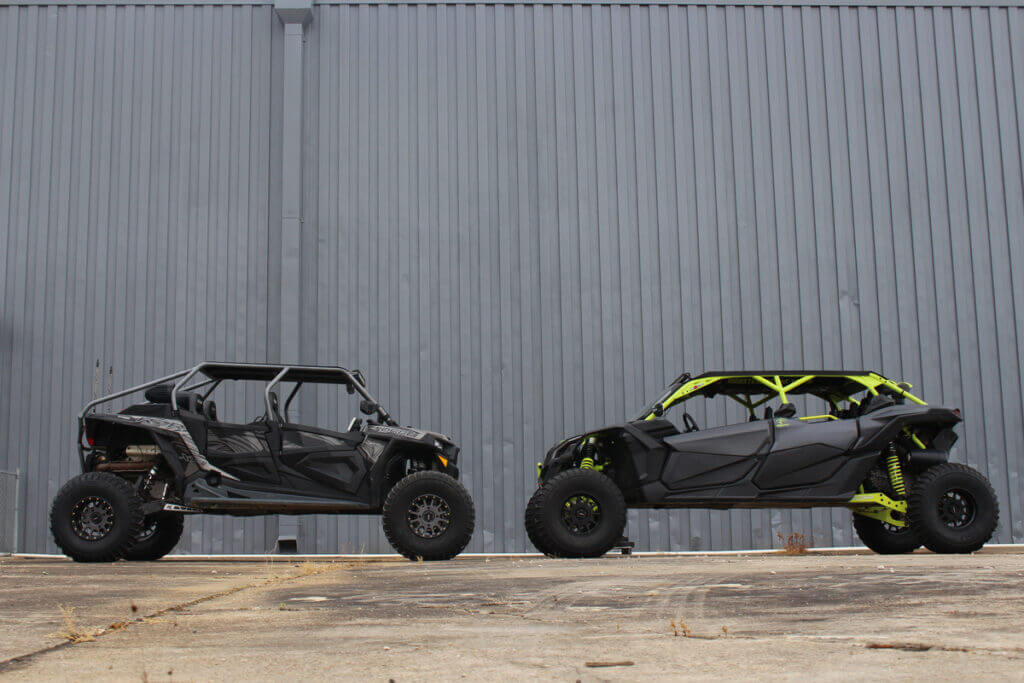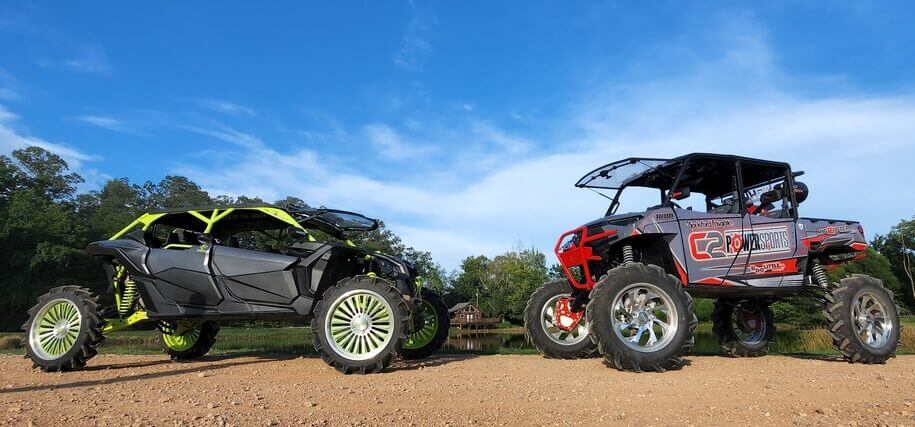
Polaris’ entry into the UTV industry in 1999 with their first SxS after revolutionizing the snowmobile market was a game-changer for off-roading fans. Can-Am was hot on their heels by 2010, with a 21st-century take on parts, performance, and durability.
It’s difficult to pinpoint what makes either the Polaris or Can-Am side by side better than the other. The debate’s gone on for years. Here’s a quick read to learn which has more horsepower, which handles better, and which is going to meet your needs. We’re diving in today to give you a straightforward pros and cons guide to comparing Can-Am and Polaris side by sides.
See which wins in each category when we set up Can-Am and Polaris’ most popular models and judge their power, ride, and trim.
Can-Am Maverick vs. Polaris RZR
Polaris Ranger vs. Can-Am Defender
Can-Am Commander vs Polaris General
Can-Am Maverick vs. Polaris RZR
We’re starting off with two of the most sought-after models either brand has produced for recreation/racing: the Can-Am Maverick X3 MAX X MR TURBO RR and the Polaris RZR Pro R Ultimate.
It’s a long list of stats here, but we want to give you the option to see for yourself.
Polaris RZR Pro R Ultimate (Left) | Can-Am Maverick X3 MAX X MR TURBO RR (Right)
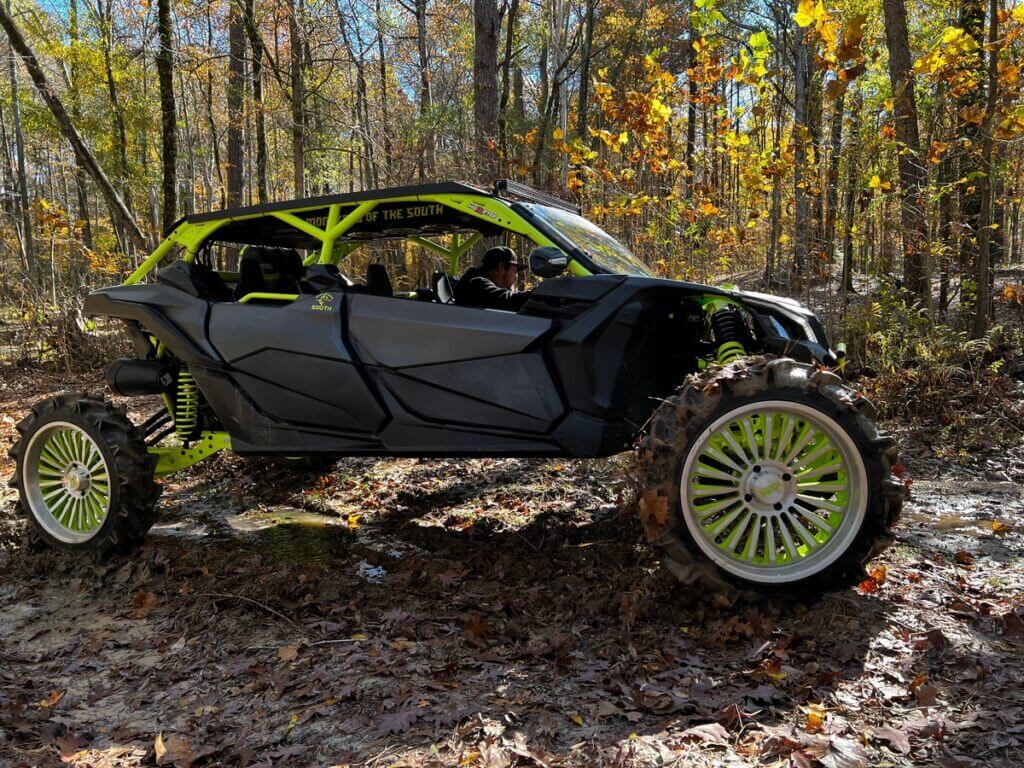
Can-Am Maverick pros:
- Horizontal In-Line Engine: Less vibration with solid bolting to the base
- ITP Cryptid Tires: Best of both worlds: great mud performance without caking throughout the treads
- Double A-Arm Suspension: Provides additional protection from rocks, debris, and offers more options for tuning
- Dual Hydraulic Disk Brakes: Ensure all your braking effort is transmitted to the brake
- Seats: 4
Utilizing a horizontal in-line engine, most Can-Am owners say they appreciate the reduction in rumble—even with 900ccs working at full-bore. Coming off-the-lot with ITP Cryptid tires means this thing’s ready for mud on day one. The unique tread pattern keeps mud moving under and away from you—without sticking in your treads.
Opting for a double A-arm suspension not only gives you more options for tuning, it provides additional protection from rocks and debris. Dual hydraulic disk brakes are a favorite for hard-riders and a favorite of Can-Am. The unique design means all of your braking effort is transmitted directly to the brake itself.
It would be hard not to mention seating: Can-Am Maverick x3 MR TURBO RRs can seat up to four riders, which is a game-changer for many. But, before you hit the web looking to get your hands on one today, take a look at what might be a deal-breaker below:
Can-Am Maverick cons:
- Mud-focused stock tires less versatile than all-terrain
- Less time for aftermarket parts to be developed (newer model)
- Slightly less travel in front and rear suspension
Although super-aggressive and useful offroad, the off-the-lot tires leave something to be desired when performing on turf, asphalt, or a more mild ride. They’re great for the more exciting rides, but you might want another set of wheels and tires to tackle a more subdued terrain.
See Can-Am Wheel + Tire Kits Here
As a younger brand in the side-by-side community, parts and accessories manufacturers have had less time to develop products, especially for the Can-Am Maverick. . With a 10-year head start in production, there are simply a lot more accessories for Polaris available.
Lastly, there’s the question of suspension travel when it comes to vehicle ride. There’s 2.2 in. less rear suspension travel on the Maverick compared to the RZR. Now, for most regular riders, that’s not the biggest deal ever. But if you’re looking to crawl rocks or explore uncharted areas, that two inches might be crucial.
There are a lot of factors to consider when choosing between these two titans of offroading. Let’s see what the Polaris RZR Pro R Ultimate brings to the table.
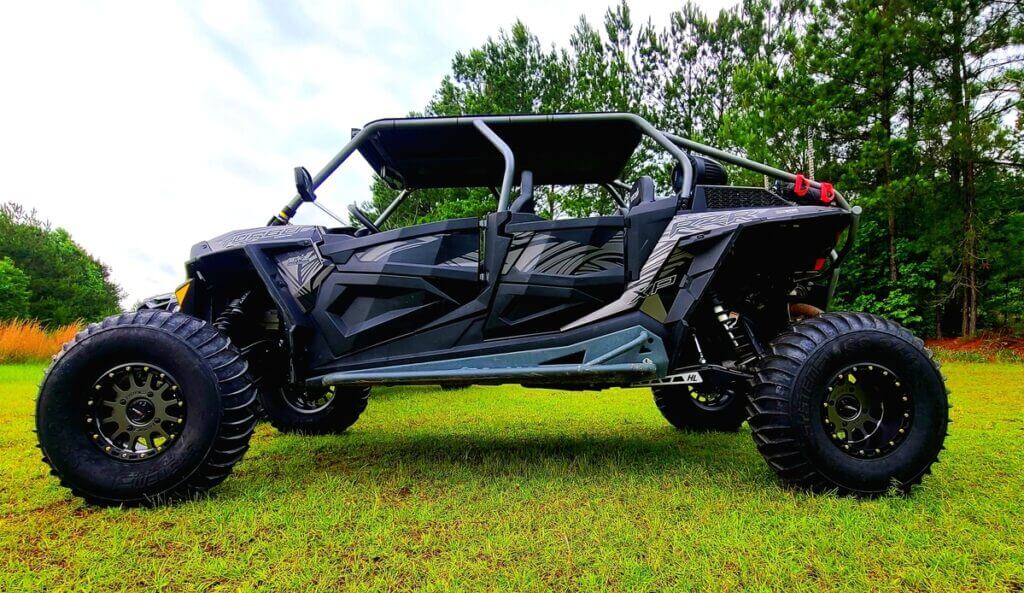
Polaris RZR pros:
- 4 Cylinder Engine: Able to facilitate more out of your throttle than a 3-cylinder engine
- Elevated Front/Rear Suspension Travel: Independent Double A-Arm suspension has a bit (0.3 Inches in front, 2.5 inches in back) more travel than the competition.
- Maxxis Rampage Fury Tires: Better clearance allows for bigger tires, , and Maxxis A/T tires offer versatility.
With an aggressive and large 997cc engine, Polaris wasn’t taking chances when it came to powering this RZR. An in-line 4-stroke engine with one more cylinder than the Maverick (4 vs. 3) helps this buggie tackle higher speeds with ease.
Making waves again, an independent double A-arm suspension on the RZR can really take a lot of punishment—while making sure you don’t. It’s stiff yet comfortable when riding messier trails. When it hits tough terrain, it’s stable enough to power through the brush, logs, and more. Paired with a couple of 32” x 10-15” A/T Maxxis tires in the back, this buggie was built to take on trails.
Does the RZR fall short in any way? It certainly doesn’t win every category. Let’s find out where the Canada-strong Can-Am might have the Minnesotan-made monster beat:
Polaris RZR Cons:
- Vertical inline engine gives more “rumble” when riding
- Brakes are not quite as responsive as competitor
- Limited cargo/storage space
As seen before in any standard vertically-aligned engine, you certainly feel the rumble of this high-powered side by side. We’ve noticed that—especially on downhill trails—the braking just isn’t quite as responsive as the Can-Am.
Surely, this is something that can be tuned, but we’re going with right-off-the-lot quality. Not to mention—there’s a limited amount of cargo space, which is a big deal for some.
Who wins? Can-Am vs. Polaris
Where Polaris came to play with the larger, more powerful engine, the Can-Am comes with a few features that can level the playing field. At the same time, the limitations on trim for Can-Am tip the scales for many riders.
What do you think? Sound off in the comments!
Polaris Ranger vs. Can-Am Defender
Known as staple workhorse vehicles, these 2022 models have some serious upgrades that make them a great choice for any rider. Both clocking in at 82 HP, they’re clearly built to compete. Let’s see who wins!
Can-Am Defender stats:
- Engine: 976 cc V-Twin
- Horsepower: 82 hp
- Ground Clearance: 12.5 in.
- Suspension Travel: 11 in.
- Wheelbase: 114.4 in.
- Overall Dimensions: 153.4 x 64 x 77.5 in.
- Towing Capacity: 2,500 lb
- Payload Capacity: 1,750 lb
Polaris Ranger stats:
- Engine: 999 cc twin-cylinder
- Horsepower: 82 hp
- Ground Clearance: 13 in.
- Suspension Travel: 11 in.
- Wheelbase: 113 in.
- Overall Dimensions: 152 x 65 x 77 in.
- Towing Capacity: 2,500 lb
- Payload Capacity: 1,690 lb
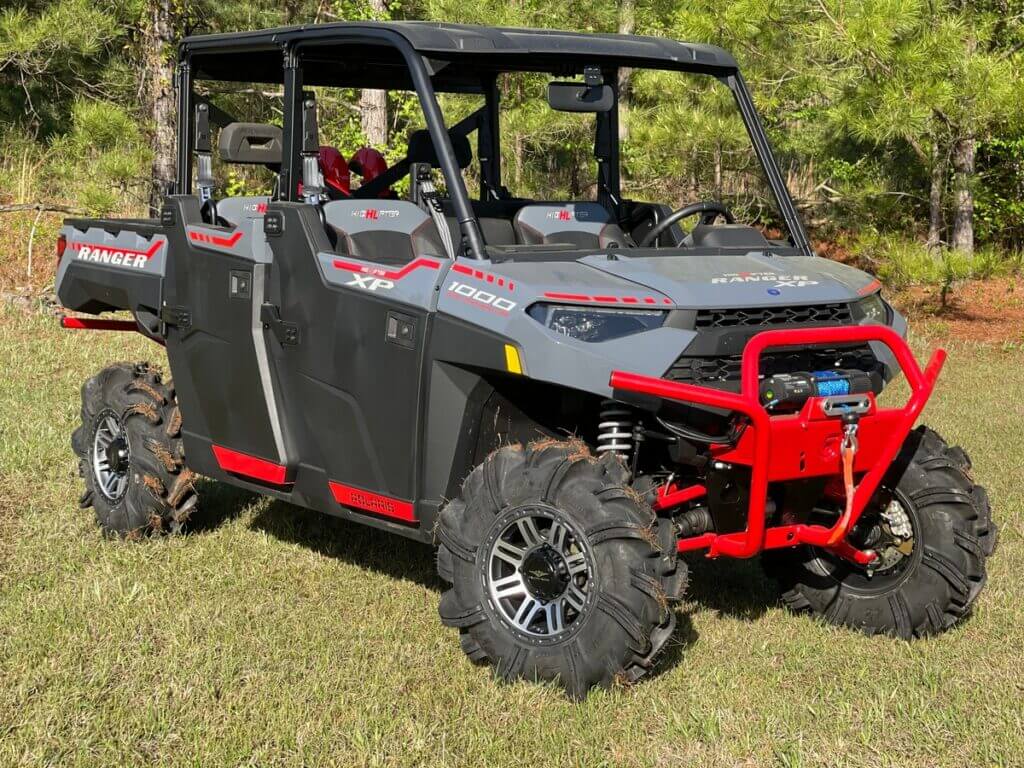
Polaris Ranger pros:
- Larger engine
- Slightly better ground clearance
- Smaller wheelbase for tighter turns
Holding true to the trend the RZR started, Polaris brings a larger engine at 999cc. The twin-cylinder puts out the same hp as the Defender, but with all the aftermarket upgrades available for performance, we hear a lot of people prefer the Polaris engine.
The Ranger does have slightly better ground clearance than the Defender. To be clear, that’s 0.5 inches more. So, your undercarriage is a bit safer, and you do ride a little higher than in the Can-Am. At the same time, it’s got a slightly tighter wheelbase. This is an advantage for riders in thicker, denser brush, or who often have to do a U-Turn.
Polaris Ranger Cons:
- Suspension tuned for lower speeds
- OEM tires offer a less smooth ride
- Slightly lower reliability rating
With a more utility-focused suspension, we’ve found that the Ranger is great at lower speeds. Once you start to hit higher revs and MPH, it gets a little jarring. Nothing that will knock you out of the cab, but it is noticeable.
In consideration of the ride of the vehicle, the OEM tires themselves can be a problem for some. Most of the people who upgrade tires on their Ranger say the stock wheels didn’t hold up as well as other aftermarket options.
Long-term use is one of the main reasons to choose Rangers or Defenders. From what we’ve seen, the Ranger just doesn’t have the same reliability. With earlier replacements for “wear” parts, it’s just a bit unfortunate for the North Star brand.
Now that we’ve heard the good and the bad from Polaris, let’s learn more about the Can-Am Defender. Starting with advantages in hauling, we’ll run down the true list of wins and losses.
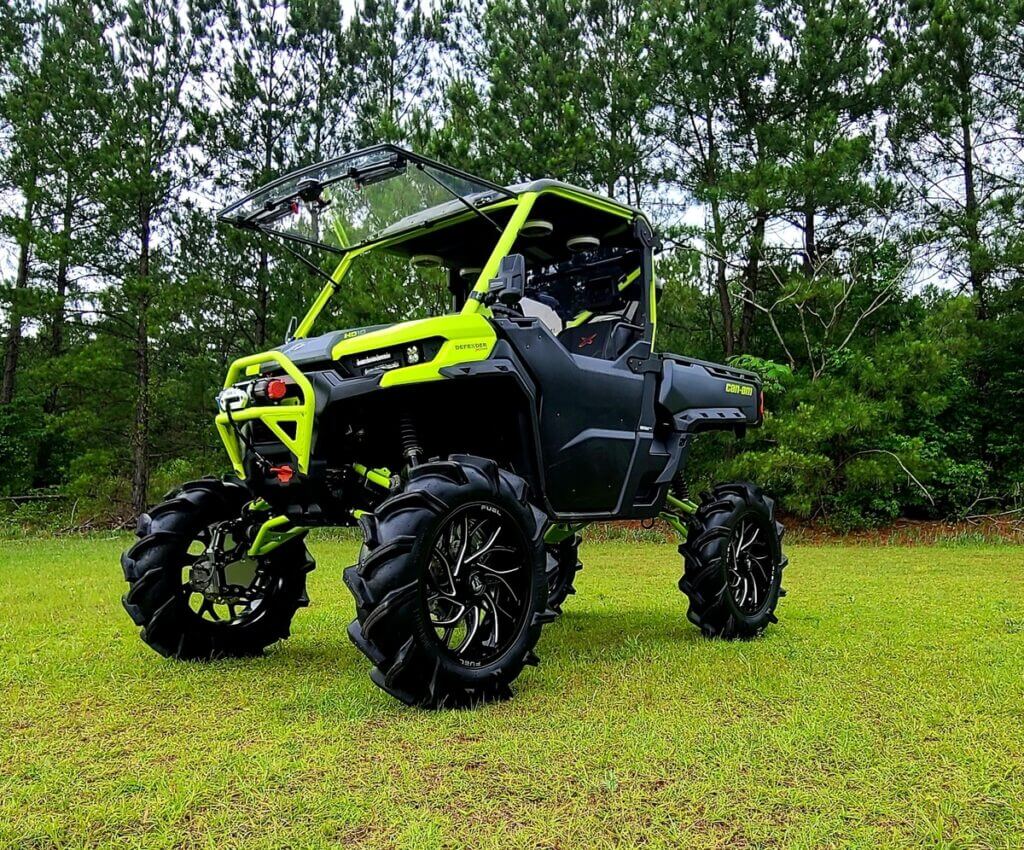
Can-Am Defender pros:
- Higher payload capacity
- Larger cargo box
- Dynamic power steering system works great
With Can-Am’s smaller engine dishing out the same hp, you might assume that Polaris would have a larger payload capacity. Actually, The Can-Am Defender has 60lb more payload available over the Ranger.
In the ride category, Can-Am stepped up to the plate with a very responsive power steering system. It was noticeably effective riding over bumps and on quick turns. With this in mind, it’s no wonder so many choose the Can-Am Defender.
To accompany the extra weight it can handle, Can-Am gave it a sizable cargo box (larger than the Ranger). With more space to haul and without having to sacrifice cab space, this is a big win in the utility and power column for Can-Am.
Can-Am Defender cons:
- Smaller engine
- Slightly lower-quality doors + upgrades
- Tuned for higher speeds, bumpier at lower speeds
Obviously, the smaller engine can be a drawback to some. Even when fuel efficiency is a big concern, the difference in fuel consumption among UTVs is a little more minimal. What a lot of riders say is, the low-end power is great, but the rest leaves a little to be desired, as far as acceleration goes.
If you’re worried about the power of your Can-Am or Polaris engine, there are superchargers, clutch kits, exhaust, and engine performance upgrades you can make. High Lifter makes it easy to upgrade your Polaris or Can-Am vehicle no matter what you need.
On a different note for trim and options, it’s been noted by some High Lifter fans that the stock Can-Am features like doors, mirrors, etc. can leave the discerning rider ith something to be desired. The Polaris and Can-Am OEM quality still leads the industry, but in this model, they put form over function a little bit.
With the longer wheelbase and supreme suspension travel, this vehicle has a smooth ride—most of the time. Some riders find that this UTV is a little wobbly at lower speeds. This makes sense, as the suspension was tuned for faster riding.
With a better payload, larger cargo box, and dynamic power steering, there’s a whole ton of High Lifter fans that say the Can-Am wins this one. At the same time, the Polaris Ranger has been a staple vehicle for thousands—for years.
The Ranger die-hards love the larger engine, tighter turning radius, and better ground clearance. For many, it’s the perfect work vehicle, and offers enough trump options to make it fun to ride as well.
With the two opposite ends of the spectrum covered, let’s look at the most popular in-between models for these vehicles. The Polaris RZR and Can-Am Maverick are ultra-sporty. The Ranger and Defender’s are there to get the job done. So, What’s the best multi-purpose side by side?
Can-Am Commander vs. Polaris General
For a balanced mix between sport and function, most riders choose between these two types of side by sides. But which wins when it’s down to the basics? Let’s find out!
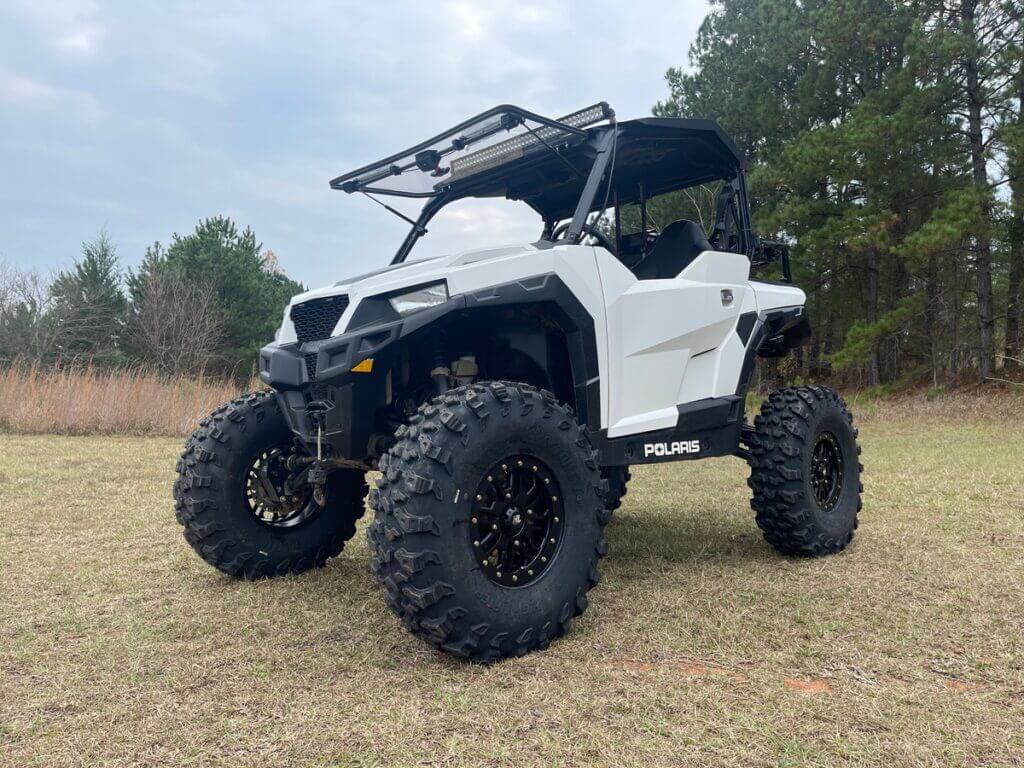
POLARIS GENERAL SPECS
- Cylinders Displacement: 999cc
- Drive System Type: On-Demand True AWD/2WD/VersaTrac Turf Mode
- Engine Type: ProStar 1000 4-Stroke DOHC Twin Cylinder
- Horsepower: 100 hp
- Front/Rear Brakes: 4-Wheel Hydraulic Disc with Dual-Bore Front and Rear Calipers
- Ground Clearance: 12 in
- Payload Capacity: 1,100 lb (499 kg)
- Seats: 2
- Front Suspension—Dual A-Arm with Stabilizer Bar 12.25 in (31.1 cm) Travel
Polaris General Pros:
- More powerful engine
- Better Ground Clearance
- More suspension travel
Polaris opted for a 999cc engine to drive a whopping 100 hp to the trails. There’s no doubt that this is redefining UTV standards for riders everywhere. The 4-stroke twin cylinder engine is known as the ProStar 100. It’s gained a lot of popularity for the power it can put out, and the beating it can take.
Ride quality is different for every demographic. For the riders who are looking to push the limits of their vehicles, the Polaris General suspension and differential has some clout. It has an additional inch of ground clearance and suspension travel over the Can-Am competition. This is handy in highly technical terrain.
Adding a locking front differential makes crawling over obstacles in the way a breeze. When one wheel starts to slip—the whole front differential locks. Most riders report that they’re slip-free in almost all situations.
Polaris General cons
- Noticeably shorter length
- Less towing capacity
- Less Suspension Travel
The first thing you’d notice if you put these two vehicles next to each other is that the Polaris is noticeably smaller. For some, the smaller turning radius is a big plus. To others, it just means you’re getting less space for storage, as well as legroom.
With the Polaris General 1000 Sport bringing in 500lb less in payload, some utility-focused fans might have a problem. But, if you’re opting to have a smaller ride, you might have to sacrifice some inertia with it as well.
Lastly, the suspension travel of the Polaris General is definitely geared towards utility usage. It has significantly less travel than the Can-Am, but offers a sufficient amount of stiffness and forgiveness across any speed.
So, how does the Can-Am Commander XT-P 100R hold up? With significant upgrades year-over-year, more and more people are becoming fans. Here’s why:
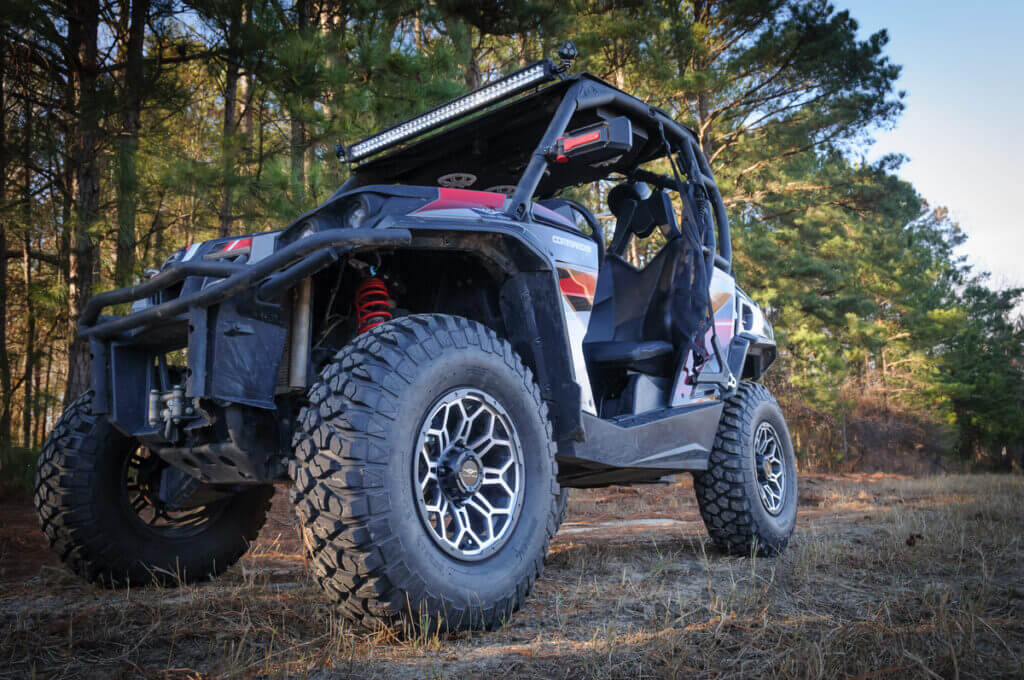
CAN-AM COMMANDER SPECS
- Engine: 976 cc, V-twin, liquid cooled
- Horsepower: 92 hp
- Drivetrain: Selectable 2WD / 4WD with Visco-Lok QE† auto-locking front differential
- Power Steering: Tri-Mode Dynamic Power Steering (DPS)
- Ground Clearance: 11 in.
- Towing Capacity: 1,500 lb
- Front/Rear Brakes: Rear: Single 214 mm ventilated disc brake with hydraulic twin-piston caliper. Front: Dual 220 mm ventilated disc brakes with hydraulic twin-piston calipers
- Included 4,500 lb winch
Can-Am Commander pros
- Better towing capacity
- Smoother braking with 214mm and 220mm ventilated disc brakes
- Included winch is substantially strong
With a bigger body, the Commander isn’t just able to hold more—it can haul more. That additional 500lb of payload doesn’t have to be used all the time, but it sure is helpful when you’re hauling an extra hundred pounds of feed. You can feel the engine’s ability to take on more tough jobs.
What we hear most about the difference in power is how you drive, how hard you lean into the throttle, and what kind of terrain you’re on. Where Can-Am feels more responsive at higher revs, the Polaris seems to hold down a better pace with less effort. When it’s that close, it seems to many to be more of a “feel” thing than anything else.
We noticed that with the latest updates to the Commander, brake efficiency was very front-of mind. The Can-Am team took a lot of effort into crafting some of the best OEM disc brakes around, and equipped this ride with the perfect size and style of brakes.
Finally—this is just a bonus for any off-roading fan. The Can-Am Commander X-TP 100R has a winch included. Not just any winch, either. Utilizing 4,500lb of pulling power, this winch is more than capable of getting your Can-Am out of whatever trouble you got it into.
Can-Am Commander cons
- Less power from the engine
- Slightly lower ground clearance
- Bumpier ride at lower speeds
It’s a fairly common theme in this article: Can-Am just uses smaller engines. This is only an issue in two scenarios: 1. You don’t plan to do anything to your side by side—you’re riding it stock. 2. You want to be the fastest out there, but the engine itself can only go so far with aftermarket upgrades.
Either way, the engine size isn’t the only drawback you might consider. Let’s look at the overall ride as well:
The lower ground clearance means there are more places to get stuck. It also means there’s a slightly higher risk of damage to the undercarriage. This can all be fixed with an Aftermarket Lift Kit, but for those who don’t want to modify, you’re stuck a little lower.
With all that being said, things like wheels, tires, and more still factor into the overall vehicle ride. Polaris might have this one beat. At lower speeds, it feels like the vehicle is a little tight when it shouldn’t be and a little loose at the wrong times as well. With a couple of quick upgrades, this can quickly be fixed as well.
It’s hard to do everything well. Polaris wins in a few areas key to the enthusiast looking to tour rather than chore, and the Can-Am Defender picks up slack in utilitarian function. Determining how you are going to use the ATV, and what modifications you are going to make, are big factors in the debate.
Who wins the Can-Am vs. Polaris debate?
The jury’s still out. Every year, when we think there’s a clear winner, the next model comes out, and we’re wowed again by the competition. Now, the only real answer we can build—starts with you!
Like and follow High Lifter on social, show us your ride, and stake your claim in the comments below this article!
Either way you go, be it the Canadian Crusher or Minnesota’s own Miracle Machines, High Lifter has the parts and accessories you need to silence the competition. Get all your UTV parts and Accessories here today!
